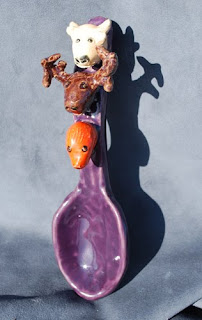Faithful Followers:
Do you remember being a first year teacher? Equal parts excitement and terror! Although I've been in the classroom for more than twenty years, I still experience happy anticipation and a few jitters at the thought of the first day of school! Below is an excerpt from an email I received a couple of days ago. I'm sure you all have helpful advice and suggestions for Debra. Please take a moment and respond to Debra via the comments link.
Hi!
I am a new art teacher and I am looking for some
help and guidance! .....
I will be teaching 6th grade (Art I) and combined classes of 7th & 8th
grade (Art II & III). I am just having a hard time figuring out how
to distinguish between the two classes and making sure they are
not all doing the same thing......
Also, I know the techniques and processes; I am just VERY confused about order and amount of time.
I was told I have to have student work ready to enter our county fair
by the end of September.....
I am hoping some kind soul will take pity on me and
give me some suggestions on order of lessons and amount of time to
expect to spend on each. ..... I have found thousands
of lessons/projects on the internet and I want to do them all – LOL-
but I know there is bound to be a logical scope and sequence I should be
following.....
I am just sitting in my classroom trying not to
panic as time gets closer....
-Debra
Hi Debra,
I am also in the process of getting ready for the new school year. I am revamping my teaching web sites so a few of the links aren't up to date, yet. Hopefully, by next week I will be ready! Now, on to helping you with your exciting, first year of teaching. First of all, congratulations on getting a job!
Here are some thoughts:
- DO THE SAME MEDIA WITH ALL CLASSES (with some differentiation for age/ interest/ ability/ state standards.)
- Choose YOUR favorite medium (if you're excited, the kiddos will be excited.)
- Then, choose several open-ended projects of various levels of difficulty. For instance, I will start with clay (my fav and middle school kids, as well) My classes are combined 7/8. Your 6th graders could do a simple slab bowl, while your 7/8 classes could make lidded boxes. A 2D example might be to have the kids do self-portraits, 6th grade could do "backwards" portraits while 7/8 would do more traditional portraits. So, your drawing lessons for 6th would focus on, for example, line, texture and space, while with upper classes you could add proportion. This would start to give you a progression for future years. You can do this with any media and any project.
- Then, pull your learning targets or lesson objectives out of the project, so, look at your state standards, break them down into specific lesson objectives eg what your students will know and be able to do from the lesson. Choose maybe two or three to address in your first unit. The learning targets will be similar for each of the grades, but the assessment criteria will be more in depth as the students get older. Just adjust the quantity/ assessment criteria for 6th versus your 7/8 class.
- Over the course of the year you will have time to start to think about future years. If you design a three year rotation on projects, then you won't have to worry about repeat students. For instance, if you start this year with portraiture, then next year your first unit could be printmaking. You use the same learning targets adjusted by grade level, but different projects/ media. Year four you start the sequence over again.








